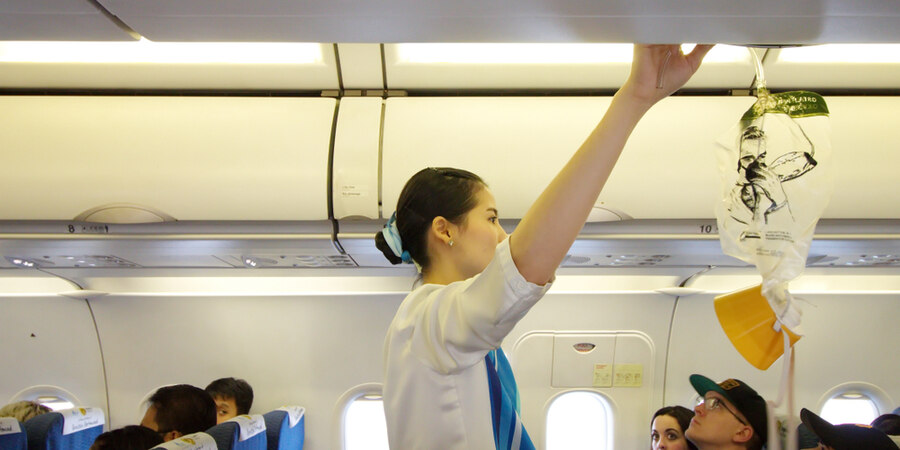Modern-day aircraft are equipped with advanced safety features and follow strict protocols. However, with numerous intricate parts in action, things can go wrong at any moment in time. Therefore, the airline crew remains prepared for any unforeseen situations. They try their best to deliver exceptional experiences while maintaining the safety of each passenger. They dispatch necessary flight safety instructions each time you board a flight. At several thousand feet in the air, this easy-to-understand do’s and don’ts can turn out to be a matter of life and death. To help you with the most important flight safety instructions, allow us to list some of them in this blog.
Top airplane safety instructions
Airplane seat belt instructions
As airplanes fly at supersonic speed, it can be difficult to maintain your posture during turbulence or unexpected maneuver. Fastening your seat belt will keep you seated and assist you from flying off in the compartment uncontrollably.
How to fasten your airplane seat belts:

1. Locate the buckle
The seat belt buckle is typically located either on the seat itself or on the armrest. Take a moment to identify its position before attempting to fasten your seat belt.
2. Insert and secure the buckle
Take the metal end of the seat belt and insert it into the buckle until you hear a distinct click. This sound indicates that the seat belt is properly secured.
3. Adjust the strap for a comfortable fit
To adjust the seat belt as per your comfort, you can adjust the strap by lifting up the flap present on the seatbelt. You should ensure that it should neither very loose so you are free to move nor be very tight and you are able to breathe properly.
4. Releasing the seat belt
Releasing the seat belt is the exact opposite of fastening it in the first place. You can also lift the flap and untie the seatbelt or can use the release button present in some seatbelts.
Please note
You should keep your seat belt fastened whenever you are seated, even though the seat belt sign is off. You should only release your seat belt in case you want to go to the washroom or have some urgency. Seatbelt will help avoid the effects of unexpected turbulence and potential injuries. If you are unable to fasten or untie your seatbelt at any point in time, you can always take the help of the cabin crew.
Suggested Read: Fun And Productive Things To Do During A Long Flight
Airplane life vest instructions
As known airplanes are prone to technical issues, that can result in pilots finding the safest way to land the plane. In some cases, runway landing is difficult or impossible. The decision to emergency landing on the water can create havoc amongst the passengers. No matter how daunting it may sound, it is effective in saving lives. Therefore one must properly understand the life vest instructions to put it on correctly and remain afloat till help arrives.
1. Retrieve the life vest
Passengers can find their life vests stored under their seat or in the seat pocket of the front seat. Life vests are usually stored under your seat or in the seat pocket in front of you. It is recommended that you locate it in real-time before the flight takes off.
2. Wear the life vest correctly
To wear the life vest, you will have to slip it to fit the body from over your head. While fastening the vest, ensure that it is not too tight nor too loose and has room to catch a breather.
3. Inflating the life vest and calling for attention
In case of a live emergency, you should pull the red tabs firmly to get your vest inflated. You can also inflate the vest by blowing into the tubes till it is fully inflated. The life vest usually includes a whistle and a light. These features can be used to attract attention and assist rescue personnel in locating you.
General flight safety precautions
In addition to seat belts and life vests, there are general safety precautions that passengers should be aware of during their flight. Given below are some of the standard flight safety precautions.
1. Emergency exit locations
There are two emergency exits in the front and two in the back. These exits have illuminated signs to remain visible in the case of light outs. Ensure to count the number of rows before sitting on your seats so that you can reach the exits conveniently.
2. Floor path markings
Pay attention to the illuminated floor path markings that guide you to the nearest exits. These markings are designed to lead you to safety in case of an emergency.
3. Safety briefing and demonstrations
The flight attendants provide the necessary information and safety briefing before every departure on every flight. You should pay close attention to the briefing about the oxygen masks, cabin pressure, and emergency procedures.
4. Follow flight attendant instructions
In the event of an emergency or evacuation, it is essential to listen to the instructions and follow the guidance of the flight attendants. They are trained to handle emergency situations and will provide clear directions on what to do.
5. Additional safety information
Airlines may have specific flight safety instructions or procedures unique to their aircraft models. Pay attention to any additional safety information provided by the flight attendants, such as the use of electronic devices, restrictions on certain items, or safety measures for passengers with special needs.

By prioritizing safety and being aware of these safety instructions in airplane, you actively contribute to creating a safer travel experience for yourself and your fellow passengers. So, the next time you step on board an airplane, take a moment to review the safety information provided and ensure you are well-prepared for any situation that may arise.
Suggested Read: Top Tips On How To Unblock Ears After Flight
Flight Safety Instructions FAQs
Why is it important to listen to flight safety instructions?
The aviation industry lays down certain safety instructions that every passenger must be aware of. It is important to listen to the flight attendant carefully to avoid human injuries, loss of life, or damage to the properties.
What should I do if I have any doubts regarding the flight safety instructions?
The airplane staff is very helpful. Feel free to ask questions for clarifications regarding flight safety.
What if I miss listening to the instructions of the flight crew?
You can find a safety manual on your seat. You can always refer to the manual or ask the attendant for any assistance or clarification.
Do different airlines have different safety instructions?
Yes, the flight safety instructions can vary depending on the type of aircraft or the airline’s policy. Therefore it is important to listen to the instructions provided.
Are planes checked for safety before takeoff?
Yes, the flight attendants and staff thoroughly check the planes for the safety of the passengers as well as the aircraft.
What should I pay attention to during the pre-flight safety briefing?
During the pre-flight safety briefing, focus on essential safety instructions. Understand seatbelt operation, locate emergency exits, learn life vest and oxygen mask usage, and review the safety card. Familiarize yourself with the brace position for emergency landings. Paying close attention during this briefing is crucial to your in-flight safety.
Are there specific safety procedures that business travelers should follow?
Business travelers should prioritize safety by staying informed about travel advisories, securing valuables, and following health guidelines during crises like COVID-19. Obtain comprehensive travel insurance, carry emergency contacts, and respect airline protocols.
How can I ensure a safe and comfortable journey while traveling by air?
For a safe, comfortable air journey, plan ahead, dress comfortably, stay hydrated, and exercise in-flight. Use noise-canceling headphones, bring entertainment, and manage jet lag. Follow COVID-19 safety guidelines, cooperate with cabin crew, and prioritize your well-being and that of fellow passengers.



